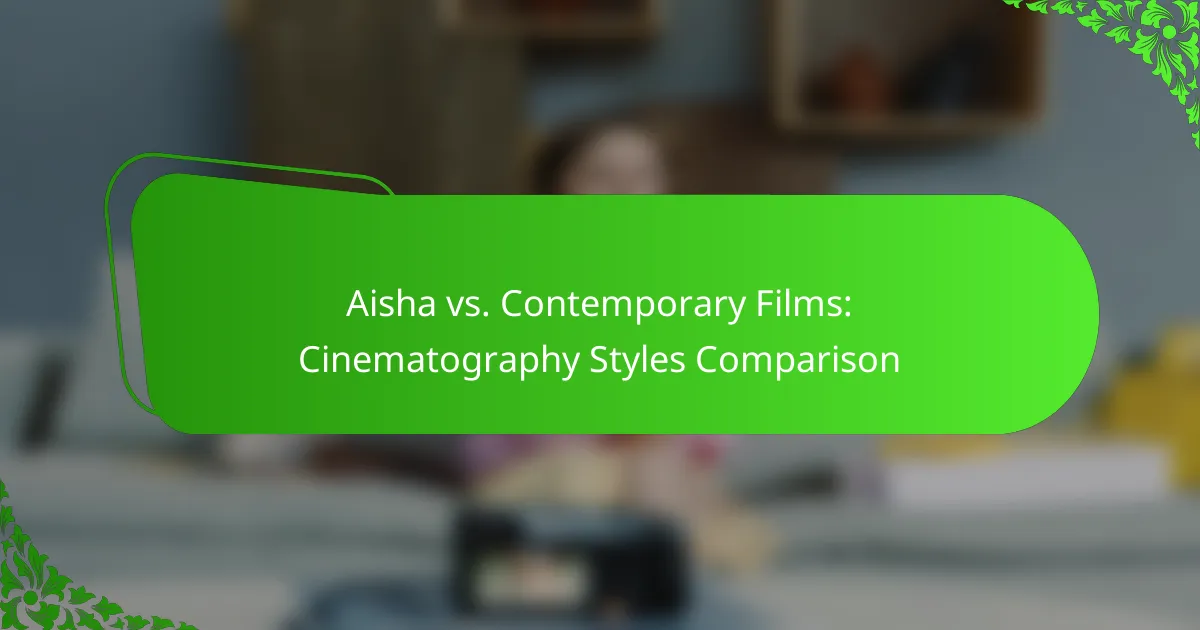“Aisha” masterfully utilizes a variety of cinematic techniques to engage audiences and evoke emotional responses. Through visual storytelling, sound design, and character development, the film creates an immersive experience that resonates deeply with viewers, drawing them into its narrative. The deliberate use of camera angles, lighting, and editing further enhances the connection between the audience and the story, fostering empathy and introspection.

How does Aisha utilize cinematic techniques to engage audiences?
Aisha employs a range of cinematic techniques to effectively engage audiences, creating an immersive experience that resonates emotionally. These methods include visual storytelling, sound design, editing styles, color grading, and character development, all contributing to a cohesive narrative that captivates viewers.
Visual storytelling methods
Visual storytelling in Aisha is achieved through carefully composed shots and framing that guide the audience’s attention. Techniques such as close-ups and wide shots are used to convey emotions and context, allowing viewers to connect with the characters on a deeper level. For instance, a close-up of a character’s face during a pivotal moment can evoke empathy and heighten emotional stakes.
Moreover, the use of symbolism in visuals enhances the narrative. Objects or settings that recur throughout the film can represent themes or character arcs, enriching the audience’s understanding without relying solely on dialogue.
Sound design impact
Sound design plays a crucial role in Aisha, utilizing ambient sounds and music to create atmosphere and evoke emotions. The strategic use of silence can amplify tension, while a well-timed score can enhance pivotal scenes, making them more memorable. For example, a sudden shift from silence to a dramatic score can signal a turning point in the story.
Additionally, sound effects are meticulously crafted to immerse the audience in the film’s world. Realistic sounds help ground the narrative, making the experience more relatable and engaging.
Editing styles and pacing
The editing style in Aisha is characterized by a rhythmic pacing that matches the film’s emotional beats. Quick cuts during action sequences create excitement, while longer takes during dramatic moments allow for reflection and connection. This balance keeps the audience engaged and invested in the unfolding story.
Transitions between scenes are also thoughtfully executed, often using match cuts or fades that maintain visual continuity. This technique helps to create a seamless flow, ensuring that viewers remain immersed in the narrative without jarring interruptions.
Color grading and mood
Color grading in Aisha is used to establish mood and tone, influencing how audiences perceive the story. Warm tones may evoke feelings of comfort and nostalgia, while cooler tones can create a sense of unease or tension. This strategic use of color helps to reinforce the emotional landscape of the film.
Furthermore, specific color palettes can be associated with particular characters or themes, allowing for visual storytelling that complements the narrative. For instance, a character’s journey may be reflected in their changing color scheme throughout the film.
Character development techniques
Aisha employs various techniques for character development that enhance audience engagement. Through backstory revelations and character arcs, viewers gain insight into motivations and conflicts, making them more relatable. Flashbacks or dialogue that reveals past experiences can deepen the audience’s understanding of a character’s choices.
Additionally, interactions between characters are crafted to reveal their personalities and relationships. Subtle nuances in dialogue and body language can convey underlying tensions or affections, allowing the audience to invest emotionally in the characters’ journeys.

What emotional responses does Aisha evoke in viewers?
Aisha elicits a range of emotional responses from viewers, including empathy, tension, humor, and introspection. These reactions are crafted through deliberate cinematic techniques that engage the audience on multiple levels, enhancing their connection to the story and characters.
Empathy through character arcs
The character arcs in Aisha are designed to foster empathy, allowing viewers to relate to the struggles and growth of the protagonists. As characters face challenges and evolve, audiences are drawn into their emotional journeys, often reflecting on their own experiences.
For example, a character’s transformation from insecurity to confidence can resonate deeply, prompting viewers to root for their success. This emotional investment is crucial for maintaining audience engagement throughout the film.
Suspense and tension building
Aisha effectively builds suspense and tension through pacing and strategic plot developments. By introducing unexpected twists and cliffhangers, the film keeps viewers on the edge of their seats, heightening their emotional responses.
Techniques such as close-up shots during critical moments and a suspenseful score amplify the feeling of urgency, making audiences more emotionally involved in the outcome of the story. This engagement is essential for creating a memorable viewing experience.
Humor and relief moments
Humor plays a vital role in Aisha, providing moments of relief amid the emotional intensity. These light-hearted scenes serve to balance the narrative, allowing viewers to decompress and enjoy the film’s lighter side.
For instance, witty dialogue or comedic situations can break tension, making the overall experience more enjoyable. This strategic use of humor helps maintain audience interest and emotional investment throughout the film.
Visual symbolism and themes
Aisha employs visual symbolism to deepen emotional responses and convey complex themes. Symbolic imagery, such as recurring motifs or color palettes, can evoke feelings and reinforce the film’s messages.
For example, a character’s journey might be represented through changing landscapes, reflecting their internal struggles and growth. This visual storytelling invites viewers to engage with the film on a more profound level, enhancing their emotional connection to the narrative.

What are the key cinematic techniques used in Aisha?
The film “Aisha” employs various cinematic techniques that enhance storytelling and engage the audience emotionally. Key techniques include camera angles, lighting, soundtracks, and dialogue delivery, each contributing to the overall impact of the film.
Camera angles and movements
Camera angles and movements in “Aisha” play a crucial role in shaping the viewer’s perspective. For instance, close-ups are often used to capture characters’ emotions, while wide shots establish the setting and context. Dynamic movements, such as tracking shots, create a sense of urgency and immersion.
Utilizing a mix of static and moving shots can keep the audience engaged. For example, a slow zoom can build tension, while a sudden cut can surprise viewers. Filmmakers should consider how each angle and movement influences the emotional tone of a scene.
Lighting techniques
Lighting techniques in “Aisha” are essential for establishing mood and highlighting key elements. Soft lighting can create a romantic atmosphere, while harsh lighting may evoke tension or conflict. The use of natural light versus artificial light can also affect the authenticity of a scene.
Filmmakers should experiment with different lighting setups, such as three-point lighting for balanced scenes or chiaroscuro for dramatic effects. Understanding the emotional implications of lighting choices can significantly enhance audience engagement.
Soundtrack and score
The soundtrack and score in “Aisha” are integral to the film’s emotional landscape. A well-crafted score can amplify feelings of joy, sadness, or suspense, guiding the audience’s emotional responses. The choice of instruments and melodies should align with the film’s themes and character arcs.
Incorporating culturally relevant music can also deepen the connection with the audience. For example, using traditional Indian instruments can enhance the film’s authenticity and resonate with viewers familiar with the culture.
Dialogue delivery styles
Dialogue delivery styles in “Aisha” significantly impact character development and audience engagement. Naturalistic delivery can make characters relatable, while stylized dialogue can emphasize themes or character traits. The pacing and intonation of lines should reflect the emotional weight of the scene.
Filmmakers should encourage actors to explore different delivery styles to find what resonates best with the character and context. Avoiding overly dramatic or forced delivery can help maintain authenticity and keep the audience invested in the story.

How does audience engagement vary across different demographics?
Audience engagement varies significantly across demographics, influenced by factors such as age, culture, and gender. Understanding these differences can help filmmakers tailor their cinematic techniques to evoke stronger emotional responses and enhance viewer connection.
Age group preferences
Different age groups exhibit distinct preferences in film genres and storytelling styles, impacting their engagement levels. For instance, younger audiences may favor fast-paced narratives and visual effects, while older viewers often appreciate character-driven plots and deeper themes.
Filmmakers should consider these preferences when crafting their stories. Engaging younger audiences might involve incorporating modern technology and relatable themes, while appealing to older viewers could mean focusing on nostalgia and emotional depth.
Cultural influences on engagement
Cultural background plays a crucial role in how audiences engage with films. Cultural narratives, values, and humor can significantly affect emotional responses, making it essential for filmmakers to understand their target audience’s cultural context.
For example, a film that resonates well in one culture might not have the same impact in another due to differing societal norms and expectations. Filmmakers should conduct thorough research to ensure their content is culturally relevant and sensitive to diverse audiences.
Gender differences in emotional response
Gender can influence how audiences emotionally respond to cinematic elements. Studies suggest that women may connect more deeply with character emotions and relationships, while men might focus on action and plot progression.
To maximize engagement, filmmakers should consider these tendencies when developing characters and story arcs. Creating relatable female characters and emotional storylines can enhance engagement among female viewers, while incorporating action and adventure can attract male audiences.

What frameworks can be used to analyze Aisha’s impact?
To analyze Aisha’s impact, frameworks such as audience reception studies, narrative analysis, and emotional response theories can be employed. These frameworks help in understanding how viewers interpret the film, the emotional connections they form, and the overall effectiveness of its cinematic techniques.
Audience reception studies
Audience reception studies focus on how different viewers perceive and respond to a film like Aisha. This involves analyzing audience demographics, cultural backgrounds, and personal experiences that shape their interpretations. By gathering qualitative and quantitative data, researchers can identify trends in audience reactions and preferences.
Key methods in audience reception studies include surveys, focus groups, and social media analysis. For instance, a survey might reveal that younger audiences resonate more with Aisha’s themes of empowerment, while older viewers may appreciate its cultural nuances. Understanding these differences can inform marketing strategies and future film projects.
Common pitfalls in audience reception studies include overgeneralizing results and neglecting the influence of external factors, such as social context or current events. To avoid these issues, researchers should ensure a diverse sample and consider conducting longitudinal studies to track changes in audience perceptions over time.










